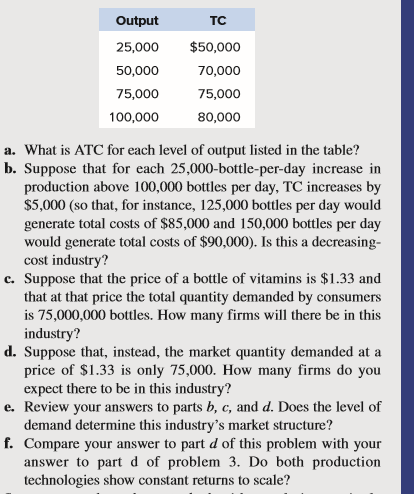Output TC 25,000 $50,000 50,000 70,000 75,000 75,000 100,000 80,000 a. What is ATC for each level of output listed in the table? b. Suppose that for each 25,000-bottle-per-day increase in production above 100,000 bottles per day, TC increases by $5,000 (so that, for instance, 125,000 bottles per day would generate total costs of $85,000 and 150,000 bottles per day would generate total costs of $90,000). Is this a decreasing- cost industry? c. Suppose that the price of a bottle of vitamins is $1.33 and that at that price the total quantity demanded by consumers is 75,000,000 bottles. How many firms will there be in this industry? d. Suppose that, instead, the market quantity demanded at a price of $1.33 is only 75,000. How many firms do you expect there to be in this industry? e. Review your answers to parts b, c, and d. Does the level of demand determine this industry's market structure? f. Compare your answer to part d of this problem with your answer to part d of problem 3. Do both production technologies show constant returns to scale?
A new production technology for making vitamins is invented by a college professor who decides not to patent it. Thus, it is available for anybody to copy and put into use. The TC per bottle for production up to 100,000 bottles per day is given in the following table a. What is ATC for each level of output listed in the table? b. Suppose that for each 25,000-bottle-per-day increase in production above 100,000 bottles per day, TC increases by $5,000 (so that, for instance, 125,000 bottles per day would generate total costs of $85,000 and 150,000 bottles per day would generate total costs of $90,000). Is this a decreasingcost industry? c. Suppose that the price of a bottle of vitamins is $1.33 and that at that price the total quantity demanded by consumers is 75,000,000 bottles. How many firms will there be in this industry? d. Suppose that, instead, the market quantity demanded at a price of $1.33 is only 75,000. How many firms do you expect there to be in this industry? e. Review your answers to parts b, c, and d. Does the level of demand determine this industry’s market structure? f. Compare your answer to part d of this problem with your answer to part d of problem 3. Do both production technologies show constant returns to scale?

Trending now
This is a popular solution!
Step by step
Solved in 4 steps


